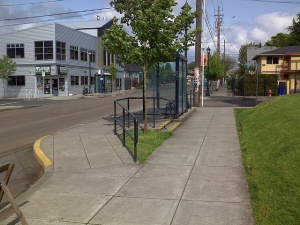Difference between revisions of "Out-of-vehicle experience"
(Moved image to top) |
|||
| Line 1: | Line 1: | ||
| + | [[File:Portland Bus Stop.jpg|thumb|right|300px|This bus stop in Portland, Ore., provides amenities like seating and shelter from the elements. Photo by Flickr user Jason McHuff.]] | ||
| + | |||
==Introduction== | ==Introduction== | ||
| − | |||
| − | |||
Certain low cost strategies, such as real-time arrival and routing information, attractive waiting areas, universal fare media, marketing/perception influence, and other measures can improve the transit experience. | Certain low cost strategies, such as real-time arrival and routing information, attractive waiting areas, universal fare media, marketing/perception influence, and other measures can improve the transit experience. | ||
Revision as of 19:11, 22 April 2015
Introduction
Certain low cost strategies, such as real-time arrival and routing information, attractive waiting areas, universal fare media, marketing/perception influence, and other measures can improve the transit experience.
The out-of-vehicle waiting experience plays a critical role in an individual’s willingness to use transit for their traveling needs. A pleasant walk to and wait at a transit stop can add value to the transit experience, while time spent in a dirty, loud, or unsafe environment is perceived to be much more costly that time spent in-vehicle.
Strategies
Real-time arrival and routing information
- Real-time information reduces anxiety about when the next bus will come
- Allows more accurate trip planning, so less time has to be spent at the actual stop
Attractive and more secure waiting areas
- Studies suggest that time spent waiting for a transit vehicle is considered more costly by the patron than in-vehicle time. However, this can be mitigated by improvements to the waiting area, such as good lighting, protection from the elements, and a comfortable place to sit.
Improvement to the quality of pedestrian network
Virtually all transit riders are pedestrians at some point in their trip. So the quality of the pedestrian network -- principally sidewalks and safe road crossings -- strongly influences the ability of travelers to access transit stops and their willingness to use transit. Factors include the presence of sidewalks, their connectivity in a useful network, and whether or not residents feel safe using them. Curb cuts and safe crossings are especially important for people who use wheelchairs or strollers. See Pedestrian connections for further discussion.
Further reading
- Victoria Transport Policy Institute. "Valuing Transit Service Quality Improvements." 2008.
- National Center for Transit Research at the Center for Urban Transportation Research, University of South Florida. “Enhancing the Rider Experience: The Impact of Real-Time Information On Transit Ridership.” 2005.
- Institute of Transportation Studies University of California, Berkeley. "The Effects of Out-of-Vehicle Time on Travel Behavior." 2006.
- Sherry Ryan and Lawrence Frank. "Pedestrian Environments and Transit Ridership." 2009.
- Portland State University Center for Urban Studies. “Pedestrian Infrastructure Improvements: Effects on Transit Use and Perceptions of the Pedestrian Environment In Portland’s Roseway Neighborhood.“ 1999.
